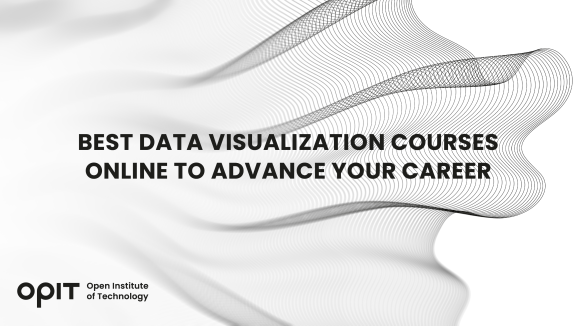

Data visualization is an essential skill in all areas of business and industry. The ability to take complex data and present it in a simple way speeds up decision-making and increases business agility. No wonder so many tech professionals are considering upskilling themselves with an online data visualization course.
If you’re a graduate looking for the best data visualization courses online, you might consider the Open Institute of Technology (OPIT). OPIT offers a Master’s Degree (MSc) in Responsible AI that includes a full segment on data analytics and visualization within the context of AI and other data sciences.
Let’s take a look at more reasons to start an online data visualization course and the benefits it can bring.
The Power of Data Visualization
Businesses thrive on high-quality data. The world generates 463 exabytes of data daily, much of which flows through busy organizations. While experienced data scientists may be able to gain snapshot analyses from complex datasets, most people can’t. That’s where data visualization comes into its own.
A data science and visualization course teaches students how to collect, cleanse, and analyze data before visualization transformations. This includes turning data into graphs, maps, or other graphic displays.
Data visualization turns raw data into usable insights. These insights allow business leaders to take action, change marketing campaigns, budget allocations, or even hiring policies. The ability to quickly see what needs to change allows businesses to edge ahead of competitors.
Choosing the Right Data Visualization Course
The best courses for data visualization teach these skills without taking busy IT professionals or data managers away from their current careers. Online courses provide flexibility and accessibility, allowing learners to study when it’s convenient for them.
Consider the following factors when choosing data visualization online courses:
- Duration
- Topics covered
- Support and student community
- Accreditation
- Career-aligned skills
- Certification
OPIT’s online courses cater to professionals with busy schedules by providing a high-level curriculum entirely online. OPIT is also fully EU-accredited and provides students with internationally recognized qualifications.
The Best Data Visualization Online Courses
Choosing data analysis and visualization courses online is tricky with so many options available. Here are five of the best currently available. Always take the above points on choosing the best online data visualization course into account before committing to a program of study.
Data Visualization with Python
This course from IBM via the Coursera platform looks exclusively at how to use the Python programming language for data analysis and visualization. Classed as intermediate level, some basic data management and programming knowledge is assumed. Tech professionals may find this course useful for upskilling themselves and learning some foundational data visualization skills.
Provider: IBM
Duration: 19 hours
Fees: $39 per month which includes access to other related courses
Qualification Gained: Digital course-specific certificate
Data Visualization Nanodegree Program
Udacity presents this “nanodegree” as a collection of four courses. The program introduces and then expands on data visualization and storytelling. Students will learn design principles, how to use Tableau, dashboard planning and design, and how to build a data story. There are also topics on data limitations and biases.
Provider: Udacity
Duration: Five months
Fees: Either month-to-month at $249 or four months for $846 (minimum $1,095)
Qualification Gained: Udacity Certificate of Achievement
Data Storytelling for Business
One of the few hybrid courses on our list, this storytelling and data visualization course does offer the option for an in-person class. However, you can also complete the program over two virtual seminars, each lasting three hours. This short course focuses on the three “Ds” of data storytelling: Define, Draft, Display, De-clutter, and Direct. It focuses primarily on helping business professionals deliver more effective, impactful presentations.
Provider: StoryIQ
Duration: One day in-person or six hours online with a follow-up session after four weeks
Fees: $230
Qualification Gained: Digital certificate of completion
Hands-On Tableau Training for Data Science
Tech professionals who want to get more out of Tableau could sign up for this software-specific data visualization online course. Tableau is a popular platform for creating data dashboards and is often used for business intelligence (BI) purposes. Students will learn about different types of visuals including charts, maps, graphs, and tables, with table calculations. There’s also a deeper dive into data aggregation and granularity.
Provider: Udemy
Duration: There are nine hours of lectures to complete at your own pace
Fees: $99 for this course but the platform has various subscription options available
Qualification Gained: Udemy Certificate of Completion
OPIT MSc in Responsible AI
For those searching for the best courses on data visualization for graduates, a master’s degree is usually the next step. OPIT’s Master’s Degree in Responsible Artificial Intelligence covers multiple AI-related topics, including data analysis and visualization. Students learn about the challenges associated with handling large, complex datasets. They cover data preprocessing, cleaning, and using that data to tell effective stories.
Provider: OPIT (EU-accredited higher education provider)
Duration: The fast-track option takes 12 months and the standard pathway takes 18 months
Fees: €6,500 — scholarships and discounts are available
Qualification Gained: Globally recognized MSc, equivalent to a Level 7 qualification worth 90-120 ECTS
Key Components of a Comprehensive Data Visualization Course
How do you choose which course is right for you? Your search should start by deciding why you want to take a data science and visualization course. If it’s simply for the joy of studying and learning new skills, one of the shorter courses might suit you. However, if you’re a graduate working in tech already, upskilling yourself will probably require investing in an MSc or similar-level course.
Here are some advanced topics tech professionals to look out for:
- Exploratory data analysis
- Crafting data pipelines in multiple programming languages
- Handling intricate datasets
- Data cleansing, processing, and integration
- Creating visualizations from multiple streams of data
- Linear and nonlinear dimensionality reduction
These skills can help you get ahead in your career by giving you the tools to work with data in any organization. Advanced data science skills are transferable and system agnostic, allowing you to apply for more roles at higher salaries.
OPIT’s Approach to Data Visualization Education
Why study with OPIT? Our unique teaching methods and course structure are deliberately career-aligned. We want to support busy professionals moving forward on their chosen trajectory. The best data visualization courses should allow you to work at your own pace, around your existing commitments.
Our teaching faculty is packed with top-notch academic leaders. We believe that choosing the right team makes the differences between good and great education. On the OPIT MSc in Responsible AI course, for example, you get to learn from Panagiota Katsikouli, a computer science researcher at the University of Copenhagen. Other top-flight faculty members include Pierluigi Casale, a principal data officer for TomTom, and Raj Dasgupta, an AI/ML research scientist at US Naval Research Laboratory.
Your course structure will include a balance of theory and practical hands-on activities. Students start with foundational theory, and then quickly learn how to apply this in real-life situations. For data visualization, expect to start with collating and cleansing data and move on to advanced analysis and presentation techniques. All courses are competency-based, with no final exams to stress about. You acquire new skills as you progress, making these courses ideal for career-minded tech professionals.
Integrating Data Visualization With Other Data Science Skills
Data visualization isn’t a standalone skill. That’s why integrating it with other data science topics such as AI and machine learning is essential. You want a skillset you can apply within your career, which means learning how it relates to various other aspects of data management. Data analysis is normally a primary step in effective visualization. However, analysis isn’t possible without first collating and processing data. The best data analysis and visualization online courses should naturally teach students how data visualization works with other data skills.
OPIT’s courses achieve this by empowering students to create industry-relevant data dashboards, pipelines, and stories. The MSc course culminates with a thesis, which is a research endeavor related to the student’s career ambitions. Learners are also encouraged to pursue internships to practice their skills and gain experience to help them achieve their career goals.
Make Sure You Choose the Right Online Data Visualization Course for Your Career
Choosing the best online data visualization course is essential to optimize your time and learn relevant skills. Make sure you understand the time commitment, cost, and qualifications you’ll gain at the end.
It’s also important to make sure you choose a trusted, accredited educational provider. OPIT’s accredited online programs could take you one step closer to your professional goals.
Explore the OPIT course offerings for more information on how we can further your tech career.
Related posts

Source:
- Agenda Digitale, published on November 25th, 2025
In recent years, the word ” sustainability ” has become a firm fixture in the corporate lexicon. However, simply “doing no harm” is no longer enough: the climate crisis , social inequalities , and the erosion of natural resources require a change of pace. This is where the net-positive paradigm comes in , a model that isn’t content to simply reduce negative impacts, but aims to generate more social and environmental value than is consumed.
This isn’t about philanthropy, nor is it about reputational makeovers: net-positive is a strategic approach that intertwines economics, technology, and corporate culture. Within this framework, digitalization becomes an essential lever, capable of enabling regenerative models through circular platforms and exponential technologies.
Blockchain, AI, and IoT: The Technological Triad of Regeneration
Blockchain, Artificial Intelligence, and the Internet of Things represent the technological triad that makes this paradigm shift possible. Each addresses a critical point in regeneration.
Blockchain guarantees the traceability of material flows and product life cycles, allowing a regenerated dress or a bottle collected at sea to tell their story in a transparent and verifiable way.
Artificial Intelligence optimizes recovery and redistribution chains, predicting supply and demand, reducing waste and improving the efficiency of circular processes .
Finally, IoT enables real-time monitoring, from sensors installed at recycling plants to sharing mobility platforms, returning granular data for quick, informed decisions.
These integrated technologies allow us to move beyond linear vision and enable systems in which value is continuously regenerated.
New business models: from product-as-a-service to incentive tokens
Digital regeneration is n’t limited to the technological dimension; it’s redefining business models. More and more companies are adopting product-as-a-service approaches , transforming goods into services: from technical clothing rentals to pay-per-use for industrial machinery. This approach reduces resource consumption and encourages modular design, designed for reuse.
At the same time, circular marketplaces create ecosystems where materials, components, and products find new life. No longer waste, but input for other production processes. The logic of scarcity is overturned in an economy of regenerated abundance.
To complete the picture, incentive tokens — digital tools that reward virtuous behavior, from collecting plastic from the sea to reusing used clothing — activate global communities and catalyze private capital for regeneration.
Measuring Impact: Integrated Metrics for Net-Positiveness
One of the main obstacles to the widespread adoption of net-positive models is the difficulty of measuring their impact. Traditional profit-focused accounting systems are not enough. They need to be combined with integrated metrics that combine ESG and ROI, such as impact-weighted accounting or innovative indicators like lifetime carbon savings.
In this way, companies can validate the scalability of their models and attract investors who are increasingly attentive to financial returns that go hand in hand with social and environmental returns.
Case studies: RePlanet Energy, RIFO, and Ogyre
Concrete examples demonstrate how the combination of circular platforms and exponential technologies can generate real value. RePlanet Energy has defined its Massive Transformative Purpose as “Enabling Regeneration” and is now providing sustainable energy to Nigerian schools and hospitals, thanks in part to transparent blockchain-based supply chains and the active contribution of employees. RIFO, a Tuscan circular fashion brand, regenerates textile waste into new clothing, supporting local artisans and promoting workplace inclusion, with transparency in the production process as a distinctive feature and driver of loyalty. Ogyre incentivizes fishermen to collect plastic during their fishing trips; the recovered material is digitally tracked and transformed into new products, while the global community participates through tokens and environmental compensation programs.
These cases demonstrate how regeneration and profitability are not contradictory, but can actually feed off each other, strengthening the competitiveness of businesses.
From Net Zero to Net Positive: The Role of Massive Transformative Purpose
The crucial point lies in the distinction between sustainability and regeneration. The former aims for net zero, that is, reducing the impact until it is completely neutralized. The latter goes further, aiming for a net positive, capable of giving back more than it consumes.
This shift in perspective requires a strong Massive Transformative Purpose: an inspiring and shared goal that guides strategic choices, preventing technology from becoming a sterile end. Without this level of intentionality, even the most advanced tools risk turning into gadgets with no impact.
Regenerating business also means regenerating skills to train a new generation of professionals capable not only of using technologies but also of directing them towards regenerative business models. From this perspective, training becomes the first step in a transformation that is simultaneously cultural, economic, and social.
The Regenerative Future: Technology, Skills, and Shared Value
Digital regeneration is not an abstract concept, but a concrete practice already being tested by companies in Europe and around the world. It’s an opportunity for businesses to redefine their role, moving from mere economic operators to drivers of net-positive value for society and the environment.
The combination of blockchain, AI, and IoT with circular product-as-a-service models, marketplaces, and incentive tokens can enable scalable and sustainable regenerative ecosystems. The future of business isn’t just measured in terms of margins, but in the ability to leave the world better than we found it.

Source:
- Raconteur, published on November 06th, 2025
Many firms have conducted successful Artificial Intelligence (AI) pilot projects, but scaling them across departments and workflows remains a challenge. Inference costs, data silos, talent gaps and poor alignment with business strategy are just some of the issues that leave organisations trapped in pilot purgatory. This inability to scale successful experiments means AI’s potential for improving enterprise efficiency, decision-making and innovation isn’t fully realised. So what’s the solution?
Although it’s not a magic bullet, an AI operating model is really the foundation for scaling pilot projects up to enterprise-wide deployments. Essentially it’s a structured framework that defines how the organisation develops, deploys and governs AI. By bringing together infrastructure, data, people, and governance in a flexible and secure way, it ensures that AI delivers value at scale while remaining ethical and compliant.
“A successful AI proof-of-concept is like building a single race car that can go fast,” says Professor Yu Xiong, chair of business analytics at the UK-based Surrey Business School. “An efficient AI technology operations model, however, is the entire system – the processes, tools, and team structures – for continuously manufacturing, maintaining, and safely operating an entire fleet of cars.”
But while the importance of this framework is clear, how should enterprises establish and embed it?
“It begins with a clear strategy that defines objectives, desired outcomes, and measurable success criteria, such as model performance, bias detection, and regulatory compliance metrics,” says Professor Azadeh Haratiannezhadi, co-founder of generative AI company Taktify and professor of generative AI in cybersecurity at OPIT – the Open Institute of Technology.
Platforms, tools and MLOps pipelines that enable models to be deployed, monitored and scaled in a safe and efficient way are also essential in practical terms.
“Tools and infrastructure must also be selected with transparency, cost, and governance in mind,” says Efrain Ruh, continental chief technology officer for Europe at Digitate. “Crucially, organisations need to continuously monitor the evolving AI landscape and adapt their models to new capabilities and market offerings.”
An open approach
The most effective AI operating models are also founded on openness, interoperability and modularity. Open source platforms and tools provide greater control over data, deployment environments and costs, for example. These characteristics can help enterprises to avoid vendor lock-in, successfully align AI to business culture and values, and embed it safely into cross-department workflows.
“Modularity and platformisation…avoids building isolated ‘silos’ for each project,” explains professor Xiong. “Instead, it provides a shared, reusable ‘AI platform’ that integrates toolchains for data preparation, model training, deployment, monitoring, and retraining. This drastically improves efficiency and reduces the cost of redundant work.”
A strong data strategy is equally vital for ensuring high-quality performance and reducing bias. Ideally, the AI operating model should be cloud and LLM agnostic too.
“This allows organisations to coordinate and orchestrate AI agents from various sources, whether that’s internal or 3rd party,” says Babak Hodjat, global chief technology officer of AI at Cognizant. “The interoperability also means businesses can adopt an agile iterative process for AI projects that is guided by measuring efficiency, productivity, and quality gains, while guaranteeing trust and safety are built into all elements of design and implementation.”
A robust AI operating model should feature clear objectives for compliance, security and data privacy, as well as accountability structures. Richard Corbridge, chief information officer of Segro, advises organisations to: “Start small with well-scoped pilots that solve real pain points, then bake in repeatable patterns, data contracts, test harnesses, explainability checks and rollback plans, so learning can be scaled without multiplying risk. If you don’t codify how models are approved, deployed, monitored and retired, you won’t get past pilot purgatory.”
Of course, technology alone can’t drive successful AI adoption at scale: the right skills and culture are also essential for embedding AI across the enterprise.
“Multidisciplinary teams that combine technical expertise in AI, security, and governance with deep business knowledge create a foundation for sustainable adoption,” says Professor Haratiannezhadi. “Ongoing training ensures staff acquire advanced AI skills while understanding associated risks and responsibilities.”
Ultimately, an AI operating model is the playbook that enables an enterprise to use AI responsibly and effectively at scale. By drawing together governance, technological infrastructure, cultural change and open collaboration, it supports the shift from isolated experiments to the kind of sustainable AI capability that can drive competitive advantage.
In other words, it’s the foundation for turning ambition into reality, and finally escaping pilot purgatory for good.
Have questions?
Visit our FAQ page or get in touch with us!
Write us at +39 335 576 0263
Get in touch at hello@opit.com
Talk to one of our Study Advisors
We are international
We can speak in:


